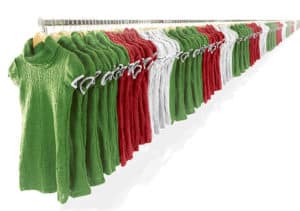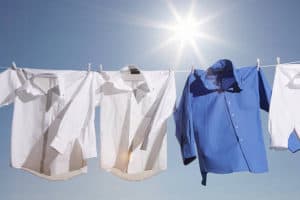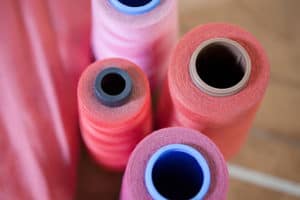Synthetic fiber is mainly used in mountain sports and cycling clothing. But does polyester keep you warm?
Table of Contents
Does polyester keep you warm?
 Whether you use the garments for hot or cold days makes no difference. Because of how they are treated, garments made of polyester, or only with a certain polyester content, usually do what you expect them to do.
Whether you use the garments for hot or cold days makes no difference. Because of how they are treated, garments made of polyester, or only with a certain polyester content, usually do what you expect them to do.
Polyester transports moisture
As already mentioned, polyester is mainly used for sportswear. The requirements are generally the same. The fabric should not make the athlete sweat too much, move moisture away from the body, and be warm on cold days without overheating.
Unlike cotton, polyester has a low absorption capacity. That’s why sweat, which occurs during intensive sports, is automatically directed outwards. This means that there is no water accumulation inside the sportswear. As a result, it causes an unpleasant chill after sports or even with small gusts of wind. Moisture is on the surface of the sportswear and can evaporate unhindered.

Harmful bacteria cannot appear because the fibers do not absorb sweat but direct it outwards. Harmful bacteria cannot appear. They, therefore, prevent an unpleasant smell of perspiration. If the clothes are regularly cleaned, they have a particularly hygienic property.
Another pro that also relates to moisture is that polyester dries particularly quickly. The shirt or pants dry quickly again after a strenuous run, an arduous mountain climb, or a demanding trail run. Even after washing, it doesn’t take long for the garment to be completely dry and usable. And it usually doesn’t need to be ironed to look good again because polyester has very few wrinkles.
Polyester can keep you warm in the cold season.
Polyester isn’t just used for jerseys and sweat pants that conduct perspiration. When used as a lining and padding, polyester can help keep you warm. That’s why you’ll find it in the lining of winter jackets and sleeping bags. The use of polyester in tents and outdoor blankets is now widespread. The mountaineer, hiker, or expedition participant is thus optimally protected at all times and can reach his destination without being restricted by external influences.
However, body heat is still required for the warming properties of polyester. As with neoprene, a warm protective film forms between the body and the garment. Cold air from outside, however, can hardly reach the body. This property is also very pros, especially for blankets and sleeping bags, if you plan to spend the night in the mountains or a bivouac. Secondly, every degree is pleasant and often extremely important in preventing hypothermia.

Cons of polyester
As with almost all fibers, there are pros and cons that you should consider. The essential Cons of this synthetic fiber is that many people can be allergic to it. It is not as easily tolerated as, say, cotton. As with sheep’s wool, itching and redness of the skin may occur in some wearers. But usually, the athlete knows about this allergy before using polyester sportswear.
Other uses for polyester besides keeping you warm
Polyester is great for other things, too, besides clothing. With thermoset, for example, you’ll find it in hard plastic parts, as plastic parts in the sports industry are made of polyester. So it is often processed in various equipment carriers and sports equipment. Another area of application for polyester is its use as fiberglass.
You will find it in the manufacture of sports equipment and articles that are incredibly strong and resistant but at the same time must be very light. Fiberglass is also found in boat building and appears in helmets, sports bows, and many other items.
Polyester is a popular material because of its various processing options and wide range of properties. Nevertheless, it is presented as a cheap and low-quality alternative to other fabrics. However, if you consider that this synthetic fiber is found in almost all jerseys, racing suits, and sports equipment for professional sports, it is evident that this statement is false.
Does polyester keep you warm? The answer is relatively warm, yes. However, we have found that it is best when used with other layers of clothing.
Continue reading
| How to Know If Your Clothes Are Vegan? | Difference Between Vegan & Cruelty-Free |
What fabrics are suitable for the cold season?

Warm clothing is essential in the winter if we want to venture outside. However, some garments that give the impression of roundness and warmth turn out to be icicles in practice. But, glancing at the label can clarify how the jacket or sweater performs in freezing temperatures.
These fabrics work well for warm clothing:
Down
Down are the lower feathers of geese and ducks. Regarding their weight, downs trap a large amount of air and thus form a very cold-resistant layer. It is often much better at keeping you warm than polyester. Be sure to buy only warm clothing that uses down from killed animals: Live feathers are extremely painful for animals!
Pros:
- Warmth. – Down has a high cuddle factor on the outside (jacket) and inside (comforter).
- With proper care, you can wear a high-quality jacket for decades.
- Machine washable. When drying, put two tennis balls in the drum. The feathers are shaken again and do not stick together.
Cons:
- Loses its warmth and sticks together when wet.
- Feathers are obtained from dead or live animals. Animal protection organizations repeatedly point out the painful plucking, which means stress and pain for the geese. If you choose a garment with down, you should find out about the origin and keeping of the animals, and treat your garments with care so that you can enjoy them for many years. With the eider duck, you get back your feathers already lost in the nests.
Animal fur
People have been using animal fur for clothing for thousands of years. However, thinking carefully about what goes beyond the actual pros is essential. Because production is often associated with significant pain for the animals
Properties:
The oldest form of clothing is the fur of animals.
Today, there is an association between the manufacture of fur clothing and the terrible torture of animals.
Pros:
- It keeps you warm and has all the functional properties that animals enjoy in the wild. This means: that fur is impervious to dust, dirt, and water.
- Fur dries quickly.
- Fur never goes out of style in winter.
Cons:
- Although fur dries quickly, it often leaves a strong smell.
- Depending on the fur you use, you must be aware of its production. Often animals are cruelly tortured and killed for their fur. To avoid this, you must be careful about where your fur comes from. For example, you can buy fur from sheep that have died, which is morally justifiable.
Does polyester keep you warm compared to wool?
About 85% of wool is air. Therefore, it is well suited to cushioning the cold and storing heat. It can absorb moisture without feeling damp. Therefore, wool is also a guarantee of warm clothing.
Properties :
Wool keeps us warm, stores heat in the body, and is breathable. It is a natural product mainly from live sheep or goats (cashmere, angora), camel, or rabbit (angora). It is the perfect material for winter. The plucked wool of angora rabbits absorbs sweat and is warm. The wool of the angora goat is called “mohair”.
There is a quality label for pure wool, the “pure virgin wool” seal. Information such as “pure wool” or “wool” may indicate poor wool quality.
Pros:
- Wool will keep you very warm compared to polyester.
- It absorbs moisture without feeling clammy.
- It hardly wrinkles, so you don’t necessarily have to iron it.
- Unlike synthetic fibers, it does not accept odors (sweat, grease, smoke, etc.) as strongly.
Cons:
- If the yarn quality is poor, small lumps and fluff (“pilling”) can appear when rubbing through jackets or bags – for example, on the hem or under the arms.
- High-quality wool garments are not only expensive to buy but also to care for. We recommend dry cleaning wool rather than machine washing it.
Fleece
Fleece is synthetic wool made from polyester. It provides excellent insulation against the cold and is also strong and durable. It is pleasant and soft on the skin and has a water-repellent surface.
So Polyester fleece is ideal for warm clothing in winter!
Polyester and other materials less suitable for warm clothing
Cotton
Cotton is a natural plant-based product. It is pleasant to the skin and comfortable to wear. However, because it cools rather than warms, cotton is not suitable for warm clothing in winter.
The cotton plant grows mainly in the United States, India, and Pakistan.
Properties:
Clothing made from cotton fibers has been around for thousands of years. The cotton plant is planted and harvested mainly in China, India, Pakistan, and the United States. The famous white cotton ball appears after the seed matures in a boll, which then bursts. Basic shirts, sweaters, jeans, and underwear are mainly cotton. However, this natural material is more suitable for summer than winter because it is airy but not warm.
Pros:
- Cheap and renewable raw material.
- Cotton clothing is suitable for people with allergies.
- The material is particularly suitable for casual wear.
Cons:
- Clothes take a long time to dry and wrinkle badly.
- They often have chemical treatments.
- Cotton is not very warm.
Does polyester keep you warm?
Polyester is a synthetic material mainly used as a surface material or a component of blended fabrics. The fabric is ripstop, and water repellent but has few warming properties.
Properties:
Polyester is plastic for textiles as well as for plastic bottles and packaging.
Pros:
- Polyester clothing keeps you warm in combination with other fabrics. Therefore, you often find it in the inner lining of jackets and sleeping bags.
Cons:
- Plastic production is not environmentally friendly due to the use of petroleum.
- Not breathable: moisture can build up and produce an unpleasant odor and skin irritation.
Viscose
Pros:
- Due to its industrial production, compared to natural fibers, viscose is particularly uniform and pure.
- It is soft and smooth.
- Compared to natural fibers, they can absorb much more moisture without giving a wet feeling. All these properties are beneficial for clothing but also home textiles.
Cons:
- The excellent moisture absorption of viscose has the problem that the fabrics swell and do not allow much or no air.
- Viscose is also not very water-resistant, so you must wash it carefully. The material can shrink during washing, and you can only dry clean it.
- Viscose is only moderately strong, and you must protect it from heavy mechanical stress.
- Fabric softeners make this situation worse.
- Viscose tends to wrinkle and can only be ironed at low temperatures. It is also generally very flammable.
Conclusion
Polyester can keep you warm in some situations. However, there are better materials you can choose to keep warm. We have found that the best way to use this material is to keep you cool in hot climates worldwide.